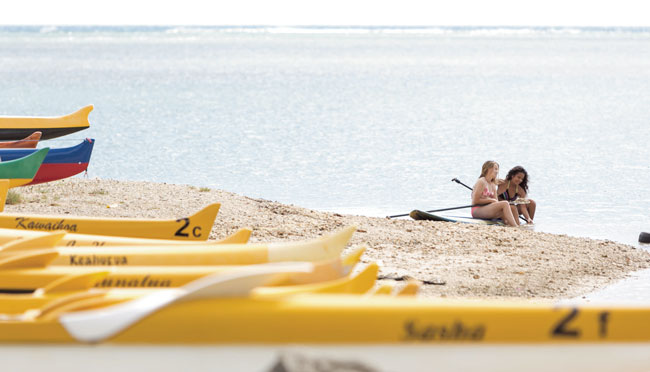New Permit Process Threatens Public Recreation Needs
Editor’ s note: Below is a letter sent April 16 to the Maunalua Bay community and endorsed by Aina Haina Community Association, Hui Nalu Canoe Club, Livable Hawaii Kai Hui, Malama Naau o Poe, Maunalua Fishpond Heritage Center,
Portlock Community Association and Wailupe Ohana Council.

Jackie Fernandez and Lenox Alexander search for shells during a recent outing at Maunalua Bay. PHOTO BY BODIE COLLINS, BCOLLINS@MIDWEEK.COM
Aloha,
Maunalua Bay is a precious natural and cultural resource in East Oahu.
Residents and organizations have great aloha for this beautiful ocean park. which is widely used by the community. While the East Oahu population has grown tremendously over the past 30 years, our ocean park area in Maunalua has not. The bay
is heavily used in a variety of ways by local ocean enthusiasts. Residents and organizations are working together to care for the bay so it will be healthy and continue to pro- vide recreation for future generations.
The state Division of Boating and Ocean Recreation (DOBOR) has created a new commercial activity permitting process statewide without true input from or engagement with the public. For nearly three decades, the Maunalua community has strongly voiced its wish for no increase in commercial activity in the bay and, in fact, has repeatedly requested a decrease. The DOBOR permitting process will open up new commercial activity out- side the state’s pre-established areas. This new process will greatly impact not only Maunalua Bay, but also community ocean recreational areas across the entire state.
The current permit process for commercial activities is in conflict with the very pur- pose and scope of Ocean Recreation Management Rules and Area, Chapter 256 of Hawaii Administrative Rules, which apply to DOBOR expressly and which state: “The purpose of these rules is to reduce conflicts among ocean water users, especially in areas of high activity.” (The division has designated 10 management areas, with Maunalua being one of them).
With this new process, DOBOR has opened up the bay for commercialization and created a situation where the traditionally understood community ocean areas will now be used for commercial activities — which will create conflict. There is a long history of DLNR non- enforcement of ocean laws in the bay. They should be adhered to and fully enforced prior to any discussion of possibly allowing new activity.
We, the (above listed) community organizations, do not want commercial businesses and activities to expand beyond the pre-established areas. We ask that DOBOR and the Department of Land and Natural Resources honor our wishes by not opening up any other areas for commercial activity in the bay and limiting com- mercial activity to the current designated areas.
We also ask that the cur- rent process be revisited to examine the manner in which the law was passed, and we ask that it be suspended until there has been true community engagement on this issue that affects community ocean recreation areas statewide.
We look forward to hear- ing from you and for your swift action regarding our requests.
Mahalo nui loa,
Ann Marie Kirk Livable Hawaii Kai Hui





